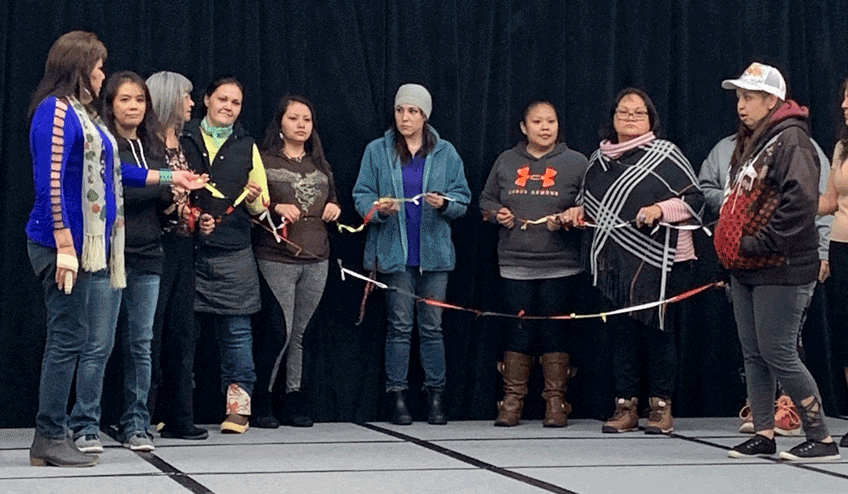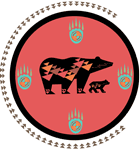The lesson, stated
The ribbon ceremony was the catalyst that established the relationship and trust that allowed the women to tell us their stories and for us to tell our stories when called upon.
In the Ribbon Ceremony, participants stand in a circle, each holding two ribbons. One at a time, each person enters the circle to invite two influential people in their lives (living or departed) to join the journey by explaining who these people are and what role they have played in their lives. The person then ties their two ribbons together (and then to the other ribbons in the chain). Afterward, the next person enters the circle to repeat the process, continuing until everyone in the circle has added their ribbons to the chain.
Cultivating genuine partnerships with the Tribal organizations and communities you work with helps bridge intercultural gaps, promote bi-directional learning, and foster a sense of trust that results in better evidence gathering with more authentic and representative information about programs. Building partnerships like these involves building trust and mutually beneficial and enriching relationships—the kind built through genuine conversation and shared experience.
Center for Native Child and Family Resilience (CNCFR) team members participated in a Ribbon Ceremony held with facilitators and participants of the Yéil Koowú Shaawát (YKS) program, part of an event celebrating women’s graduation from the program. CNCFR staff were invited to the graduation, which was concurrent with their site visit. The Ribbon Ceremony provided an opportunity for the Center team to share with the community as the community would be sharing with them, setting the stage for deeper partnerships to develop through the work done together and creating a physical reminder of the bonds being created.

The stories
In sharing, I recognized the trust that emerged after. The real trust that comes with identifying with another human and their lived experience. The ceremony helped us see beyond the preconceptions attached to the titles we carry. We were bound together in a circle of trust. The tying of the ribbon signifies the bond among group members to their spirits, ancestors or loved ones who joined the circle.
The Ribbon Ceremony, conducted early on in our work, provided an opportunity create a genuine partnership between the community and the Center because it started the process of dissolving the established scripts each group had about their role in the processes that were about to unfold as well as about the roles of the people in the other group. Sharing personal histories and emotional lives made possible a levelling—no longer a formal arrangement of evaluators and evaluated, but people working together to tell the story of a program by scaffolding the community’s ability to tell that story—that fostered the kind of trust that allowed for deeper discussions about the program, its participants, and the outcomes they created.
The ceremony was very emotional for me as it brought back remembrances of when I was a child. Tying the ribbon together felt like developing a bond that could never be broken. And, when things become difficult, I realized there are tangible objects, that will help me move forward when needed. In this case it was the ribbon and the remembrance of how strong the women were who definitely became the warriors they sought to be through participation in the group.
Bridge Intercultural Gaps
As Patricia went around the circle, she paused as each person carefully wafted or waved the smoke over themselves with their hands. The women did this very carefully, making sure to wave the smoke around their heads, legs, and backs in an almost meticulous manner. There seemed to me to be specific learned motions for addressing the smoke to different parts of the body. These movements appeared almost formal, ceremonial. I was aware at this time of smudging as an important practice, but I don’t think I’d ever participated in it. For a moment, I was unsure if what I should do. Should I attempt to waft the smoke on my body as others had done? Would I be appropriating a cultural practice I didn’t really understand? I didn’t think anyone would have objected—I just felt uncomfortable. When Patricia came to me, I smudged, attempting to wave the smoke around my body the way the women had, but I was hesitant, awkward, and probably looked pretty ridiculous.
Years later we returned to that same stage as part of a celebration of the achievements of Amalia Monreal and the YKS program. By this time, I’d gotten to know Amalia, Mary, and Patricia pretty well. I’d learned more about the women from the YKS group who’d participated in the ribbon ceremony and like myself were attending this celebration years later. They were familiar faces by this time, no longer strangers. I remember making some jokes when members of the Center team were brought on stage to be thanked for their work on the project. Maybe I felt that I’d earned a place in the room by this time, at least the right to be there as a partner supporting the Tribe’s work.
While there is some material available about how to respectfully interact with Tribal communities (see below for examples), much of that work addresses the formal aspects of these relationships. However, building genuine partnerships across perhaps numerous cultural divides requires finding ways to connect with one another outside of the structures imposed by formal relationships. Participating in ceremonies can be a critical way for building bridges and, thereby, partnerships.
Promote Bi-Directional Learning
You join in, ask, learn—you do the best you can.
Another way that evaluators partnering with Indigenous communities may need to reorient themselves is by entering the work with humility and the understanding that they, too, are learners in this partnership. Both the evaluation team and the community bring expertise and experience to the work, and being intentional about working with the Indigenous community and its programs can expand everyone’s skills and knowledge. These bi-directional effects were not limited to learning about culture or programs; it included healing, appropriately enough given the role of culture as healing and that promoting a community’s health promotes the health of people in that community:
After COVID hit and we were all working remotely, we needed to do Talking Circles virtually. In one Talking Circle, we were working on understanding the potential impact of Phase I. My 9-year-old niece was in the next room coloring during the meeting. Unbeknownst to me, she was listening to the incredible and heart-wrenching stories of the women, which always left me feeling overwhelmed by the disparity between their experiences and the privilege I had to not have to endure some of their life struggles. As we were closing the Talking Circle, my niece walked up to me and whispered, “maybe someday my mom can be like them”—the strong women that were speaking in the Talking Circle. I broke down into tears as this young person could see the level of strength these women had to crawl out of the life stories they had been living and the resilience it took to do that. Amalia saw me in tears as I could not see fast enough to turn off the camera. She asked what happened and I told her what my niece had said. The women began talking to my niece and encouraging her in a way only family could. It felt safe and vulnerable and overwhelming and raw, all at the same time.
Gather Better Information About Programs
I knew it was difficult for the women participating in the Talking Circle because as they spoke, they held the ribbon for support. But even though they may have been nervous, they were able to tell us about their lives and how the women’s group inspired them to be strong. If it wasn’t for the ceremony that began everything earlier, it may have been difficult, if not impossible, for them to tell their stories.
One of the challenges facing those implementing Western-style evaluations in Indigenous communities is the most fundamental: gathering information. The history of Western research in Indian Country is filled with cautionary tales and overcoming that context—which is current as much as it is historical—requires building relationships with the community. If you have a genuine partnership, you will be able to get buy-in and trust from the community—which opens up the possibility of getting richer, more candid responses about the program’s story than you might get from more formal approaches to the evaluation or to the community. In addition, developing these partnerships provides important inroads to sustainability and capacity building as much as it fosters the community’s ability to tell its own story; the partnership can help scaffold the community to ask its own questions and take the lead on evaluation efforts.
Resources
-
A Roadmap for Collaborative and Effective Evaluation in Tribal Communities
Children’s Bureau, Administration for Children and Families, U.S. Department of Health and Human Service -
Walk Softly and Listen Carefully: Building Research Relationships with Tribal Communities
National Council of American Indians -
Research & Evaluation in Native Communities Resource List
Capacity Building Center for Tribes -
Starting the Journey: Initial Considerations for Researchers Working in Indigenous Communities
Center for Native Child and Family Resilience -
Resilience-Based Program Resources for Tribal Communities: How Can I Ensure the Program Is Helping the Community?
Center for Native Child and Family Resilience


